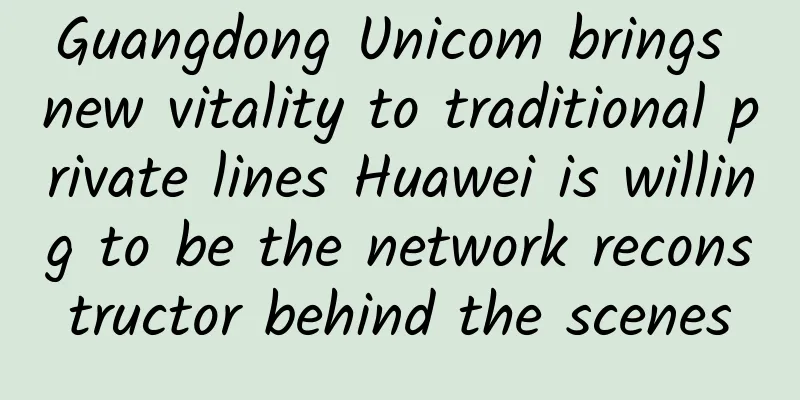Guangdong Unicom brings new vitality to traditional private lines Huawei is willing to be the network reconstructor behind the scenes

|
[51CTO.com original article] During the 4th Global Ultra Broadband Forum (Ultra Broadband Forum 2017, hereinafter referred to as "UBBF"), Huawei's rotating CEO Xu Zhijun said that he will work with operators to jointly create an agile and good experience B2B private line service to enable the growth of operators' private line business. Although this is the first time that Huawei's senior management has clearly expressed their emphasis on operators' B2B private line services in public, in fact, Huawei has already begun to explore in practice with domestic operators. In January this year, Guangdong Unicom and Huawei took the lead in launching the SD-UTN intelligent government and enterprise private line commercial service in Guangdong. After more than 9 months of development, how is the project progressing? What valuable experiences can be shared? After the meeting, Zhuang Biao, deputy general manager of the network construction department of China Unicom Guangdong Branch, and Hu Wei, general manager of Huawei's business router field, jointly accepted an interview with reporters and shared their understanding of private line services. Feel the push from users Zhuang Biao pointed out that in order to maintain growth in a competitive environment, the entire communications industry is actively transforming. Guangdong Unicom's transformation has three directions: first, to develop towards quality, efficiency and scale; second, to achieve the upgrade of new digital services, from traditional simple communications services such as voice, traffic and broadband, to the transformation of the Internet of Things, big data and cloud computing, and to be highly integrated with the industry; third, to transform from traditional closed to open. The reason why the transformation focuses on B2B private line business is that Guangdong Unicom found that the growth of ICT revenue is very fast. In 2014, ICT revenue was only 3 billion, but it grew to 4.4 billion in 2016. From the perspective of business structure, the growth rate of Guangdong Unicom's traditional network business in 2016 was only 8.5%, but the growth of government business reached 23.6%. In the process of development, the digital transformation of industry users has also placed higher demands on operators, which in turn promotes operators to make changes from the bottom up. Zhuang Biao divides them into three categories: First, there are industries that have always had a strong demand for dedicated lines, such as the financial industry: in the past, 2M or 10M bandwidth could no longer meet the demand, and financial institutions often proposed the need to open 100M bandwidth, which not only requires dedicated lines, but also has very high security requirements. The second is the science, education, culture and health industry. Users in this industry often have many branches and are scattered, but the need for flexible bandwidth is becoming more and more obvious. For example, in the medical industry, sometimes 2M bandwidth is enough to transmit some medical files, but once it involves medical video teaching, high-bandwidth services need to be opened immediately. Obviously, the tariffs of traditional communication services are difficult to meet the needs of flexibility. The first category is commercial buildings. Currently, commercial buildings mainly use dedicated Internet lines as their main products. There is often a conflict between the flexibility of traditional networks and customer needs, which needs to be resolved urgently. How to quickly adapt to the needs of dedicated line users? How to deal with the changes in the private line market? Guangdong Unicom chose to follow the trend, actively restructure and transform, and quickly adapt to the transformation of industry users. Zhuang Biao summarized several experiences from the practice of Guangdong Unicom. First of all, traditional operators need to bring networks and optical fibers as close as possible to customers in need. This is because Guangdong Unicom's past networking was mainly based on mass household products, while the network architecture for the enterprise market is completely different, and it needs to be designed more in line with the needs of the enterprise market. Secondly, traditional private networks are chimney-style, with each network isolated and relatively independent. However, operators now need to reconstruct the network from the basic bearer network to improve openness while enhancing capabilities. Third, operators can refer to Internet companies and carry out iterative development. For example, the network's openness and elasticity capabilities can be turned into iterative and implementable forms. On the basis of reconstructing business processes, they can provide customers with differentiated products, thereby forming real competitiveness in the market. Guangdong Unicom B2B Private Line Growth Path Zhuang Biao told reporters that during the exploration, Guangdong Unicom found a good entry point, introducing SDN on the UTN network and reconstructing the basic bearer network. Initially, UTN was intended to be a comprehensive bearer network, but in the past few years it has been playing the role of a mobile backhaul network, which is still far from a truly comprehensive bearer network, so it must be transformed and reconstructed. The introduction of SDN has improved the network's ability to open up to the outside world. While improving internal management capabilities, it has also achieved process connectivity between customers and business systems, making it open. As we all know, business process reengineering is very complicated, because the real product must penetrate all internal links and truly form a standardized product before it can support the development of the business. After several attempts, Guangdong Unicom finally broke through this barrier. It is understood that Guangdong Unicom has now created a closed loop that penetrates the business end and client to the cloud BSS system and then to the OSS operation and maintenance system. This brand is SD-UTN intelligent private line, which truly realizes the agile opening of private line services, autonomous real-time adjustment of elastic bandwidth, and active maintenance. It can customize products flexibly according to customer needs in terms of traffic, bandwidth, and time, and customers can also monitor the quality of the private line in real time. Taking Zhixiang Private Car as an example, customers can adjust the speed of the original 10M Internet private line to 100M private line independently from 50 hours of speed adjustment per month. At present, the three major products of SD-UTN smart private line are Internet access private line, networking private line, and cloud network private line. Zhuang Biao revealed that after several months of development, some specific projects have been implemented, such as the environmental monitoring data of Guangdong's environmental monitoring industry, which is carried and transmitted through UTN networking; and the demand for cloud network private line will be more extensive, such as: providing cloud services for production systems in Guangdong's medical industry, and medical institutions at all levels use SD-UTN smart private lines to meet the bandwidth requirements of various production scenarios and flexible adjustments. According to Zhuang Biao, in the future, Guangdong Unicom will work with Huawei to accelerate the implementation of B2B dedicated line services, including coverage of business buildings. Next year, it plans to continue to increase coverage of business buildings across the province and improve the depth and breadth of the overall coverage. In addition, it will deepen industry applications, including science, education, culture, health, government, finance, and medical care, and deepen the improvement of dedicated lines and basic networks in these major industries. Network reconstruction drives business reconstruction Hu Wei, general manager of Huawei's business router field, said that in the development of Guangdong Unicom's dedicated line business, Huawei has always played the role of an enabler, giving full play to the innovative advantages of solutions and products in network reconstruction. In the SD-UTN project, based on the rich terminal resources of the UTN network, the new CPE accurately covers the target government and enterprise users, and the network bandwidth is smoothly upgraded to meet the needs of neat dedicated line bandwidth (such as: UTN access ring is upgraded from GE link to 10GE link); at the same time, the low latency and slicing capabilities provided by Huawei's IPRAN solution enable the co-carrying of mobile network services and government and enterprise dedicated line services on the UTN network, helping SD-UTN to develop a platform to create multiple services and truly realize business reconstruction. In addition, Huawei also introduced an open architecture SDN control and integration layer, providing an API method to connect with the outside world in the form of a general interface to achieve business iteration innovation. Of course, we must go fast and steady. Hu Wei emphasized that we must be fast in the process of new business innovation, but we must also pay attention to standardization. Only when the entire industrial ecological chain of manufacturers and customers moves towards standardization, reduces costs and improves efficiency, can we establish an active ecology. When asked by reporters about the differences between the dedicated line services provided by Internet companies and those of operators, Hu Wei believes that there are still major differences between the two. The most obvious difference is that Internet companies lack a widely covered network and do not have their own "nerve endings", while operators' dedicated line networks are different. By leveraging the natural advantages of operator networking, they can achieve end-to-end full coverage, including user business operations and cloud computing. These "nerve endings" can provide reliable network quality and even allow users to switch networks "without noticing". He told reporters that from Huawei's perspective, the capabilities currently built in Guangdong Unicom's SD-UTN can also be replicated in other provinces of China Unicom and even in foreign mobile-based operators to support the development of global operator government and enterprise business. Hu Wei gave an example, an operator in a certain country overseas has achieved 100% fiber coverage, with 30,000 base stations serving wireless users, but has not made good use of the value of these users. They hope to use site fiber for integrated access. At this time, Guangdong Unicom's solution can be fully replicated to help them develop B2B business and extend it. "In essence, with the progress of fiber opticization, one fiber can be used for multiple purposes, one network can be used for multiple purposes, and the value of the maximized IPRAN network will become a reality." [51CTO original article, please indicate the original author and source as 51CTO.com when reprinting on partner sites] |
<<: Traditional routing, SD-WAN gives you a reminder
>>: How edge computing and fog computing change the way IoT is used
Recommend
LoRaWAN for public, private and hybrid networks
Established network connectivity technologies off...
Seven key points! Understand the "Threat Information Blue Report" released by Weibu Online and China Academy of Information and Communications Technology
On December 3, 2021, the Security Research Instit...
ServerHost: $1/month KVM-1GB/15GB/1Gbps unlimited traffic/8 computer rooms available
Today's topic is $1 VPS, and here's the i...
Network Automation: The Core Competitiveness of Operators in the 5G Era
[[327272]] What is the core competitiveness of op...
From IP to IP, let's talk about the "useless" knowledge in computer networks
Web development is inseparable from computer netw...
Single machine million TCP connection test source code
[[382120]] This article is reprinted from the WeC...
Is HTTP1.1 Keep-Alive considered a long connection?
[[435412]] This article will talk about the collo...
LiCloud: $34.99/month - E3-1230v2, 8G memory, 240G SSD or 1TB HDD, 30M Hong Kong server
LiCloud.io has released a promotion for June. Com...
[Black Friday] iWebFusion Los Angeles Server Big Discount, Starting at $35 E3-1230v6, 16G Memory, 2TB Hard Drive
iWebFusion is the iWFHosting that the tribe has s...
Operators' user development under severe cold weather, some are happy while others are sad
It is time for operators to release their monthly...
[Black Friday] spinservers: 10Gbps San Jose/Dallas servers starting at $89/month, 50% off on all hybrid servers, $200 off on high-end servers
The Black Friday promotion of spinservers continu...
The Ministry of Industry and Information Technology has issued an "iron order" that if you want to port your number to another network, you must meet these three conditions!
As we all know, the three major operators are amo...
Discussing the five key technologies for building 5G
It is widely believed that 5G mobile networks wil...
5G and the Internet of Things empower the home appliance industry to promote the consumption of green and energy-saving home appliances
The great progress of social productivity has giv...
edgeNAT Mid-Autumn Festival/National Day Promotion: VPS monthly payment 30% off, annual payment 40% off, US/Hong Kong/Korea VPS monthly payment starts from 42 yuan
edgeNAT sent a promotional plan for this year'...

![[Black Friday] HawkHost virtual hosts up to 30% off, reseller hosts up to 50% off, cloud servers up to 30% off](/upload/images/67cac47515d63.webp)







